Welcome to one of the most active flamenco sites on the Internet. Guests can read most posts but if you want to participate click here to register.
This site is dedicated to the memory of Paco de Lucía, Ron Mitchell, Guy Williams, Linda Elvira, Philip John Lee, Craig Eros, Ben Woods, David Serva and Tom Blackshear who went ahead of us.
We receive 12,200 visitors a month from 200 countries and 1.7 million page impressions a year. To advertise on this site please contact us.
|

|
|
RE: Looking for good book on music theorie
|
You are logged in as Guest
|
|
Users viewing this topic: none
|
|
Login  | |
|

   
kitarist
Posts: 1715
Joined: Dec. 4 2012

|
 RE: Looking for good book on music t... (in reply to Ricardo) RE: Looking for good book on music t... (in reply to Ricardo)
|
|
|
quote:
The thing you linked to, Persian equivalent of segah certainly points out that it “derives” from Rast, both modally and by name...segah meaning third place as in the third degree of RAST.
That's not it though. Third is not a reference to a degree of a mode/maqam.
I was now looking through the Persian/Iranian traditional music system as the common ancestor of the Arabic and Turkish system we are discussing.
The names Dogah, Segah, Cahargah and Panjgah are Persian (Segah -> Sikah /Segah; Dogah -> Dogah; Cahargah -> Çârgâh; ).
When literally translated, they indicate respectively second place, third place, fourth place and fifth place. It is believed that this 'place', in the context of medieval music, referred to the position of the respective finalis ("tonic") of these modes, in relation to a fundamental pitch, on the fingerboard of lute-type instruments. (though now that original meaning is not operative as there is no fundamental pitch; just pitch relations and melodic rules).
The Persian system is more akin to modes, with seven of them (Dastgah), and a couple of those have more than a single subtype (avaz), for a total of about 12 avaz.
I find that the Persian theorists explain things better (and it helps getting to understand the notation of the Arabic/Turkish system better).
The Persian dastgah are also written out as ascending-ordered scales (like the Arabic/Turkish versions), but practitioners have no concept of a scale (there is not even a native word for scale in Persian) - as it is not serving any melodic purpose so it makes no sense to them.
So rather, a dastgah (and jins/maqam, and makam) is more like the set of notes typically played when within a certain modal 'mood'. It includes rules for what notes are special in terms of the set of melodies in existence for each: the final i.e. 'tonic'; note; the improv-starting note, the typical range for main melodies (that would be also the tri-, tetra- and penta-chords marked in Arabic and Turkish systems), then the notes used beyond that range - either for melismas or for approaching the finalis, etc., ALL OF WHICH makes what is called a certain dastgah.
Example: the Persian Segah:
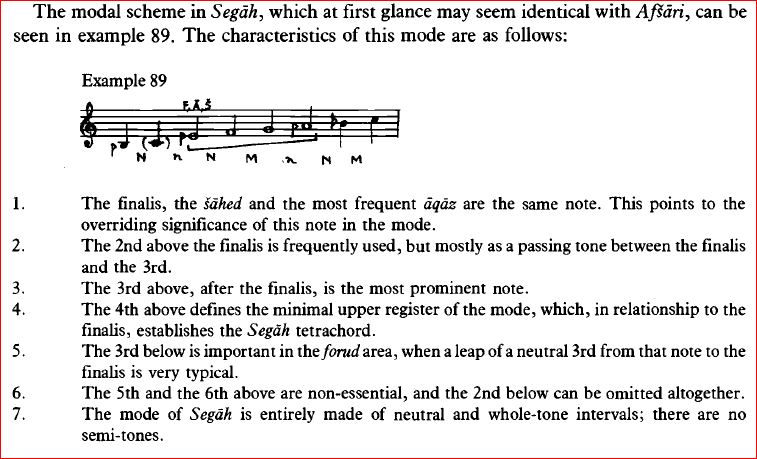
where
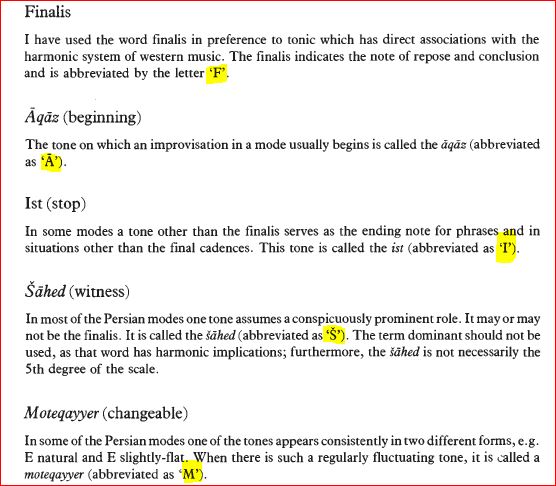
So what is notated is that in Segah, the Ed note is the finalis F ("tonic"), but also the usual note for starting improvisation A and the most prominent note S (reemphasizing its importance in this 'mode').
We also see the four notes, the ascending tetrachord from Ed, shows the typical range within which the melody stays, what they call the minimal upper register of the mode.
And so on. From looking at this, I believe the staff notation of the jins is meant to convey essentially the same types and quality of information about them; hence the 3-,4-,5-chord being kind of in the middle of the 'scale', and the additional notes in smaller font above and below the 'tonic' note. Because of this, the octave of the pitches actually used matters, so they end up presenting the notes such that the 'tonic' is not the left-most note on the ascending scale - without the implication that the tonic is not the tonic - they don't display the notes below the tonic as pitches one octave up so it is 'proper order' because the pitches occur as shown, not an octave up.
The Persian theorists then show representative examples of melodic fragments classified in certain ways; here I show an opening and a cadential fragment:
A representative opening (daramad) in Segah (one can check and see that the characteristics/rules described above are indeed followed):

A representative cadential fragment (forud) in Segah:
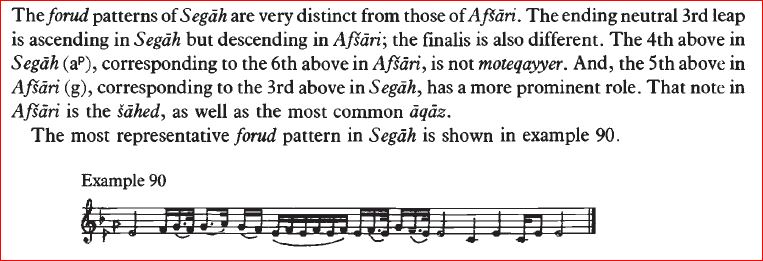
Images are resized automatically to a maximum width of 800px
 Attachment (4) Attachment (4)
_____________________________
Konstantin
|
|
|
|
REPORT THIS POST AS INAPPROPRIATE |
Date Oct. 17 2020 0:10:57
 |
|

   
Ricardo
Posts: 14806
Joined: Dec. 14 2004
From: Washington DC

|
 RE: Looking for good book on music t... (in reply to kitarist) RE: Looking for good book on music t... (in reply to kitarist)
|
|
|
quote:
When literally translated, they indicate respectively second place, third place, fourth place and fifth place. It is believed that this 'place', in the context of medieval music, referred to the position of the respective finalis ("tonic") of these modes, in relation to a fundamental pitch, on the fingerboard of lute-type instruments. (though now that original meaning is not operative as there is no fundamental pitch; just pitch relations and melodic rules).
Right, well you quoted from before my last post. The name “segah” was the third place note NAME, for whatever 8 note scale the ancients used, yes. The first place was called yegah. The point was they used that name, and chargah (4th place) for the Turkish Rast makam to call it’s third degree...which just so happened to be slightly flat in Rast. The name is now associated with that specific note in the entire 53 note system as a whole. But my point was that this note was FIRST DERIVED from somewhere else. So what I am saying is segah HAS to be a little flat because THAT is what they wanted RELATIVE to Rast. (I wish I had a nickel for every time a western singer meant to sing an Equal tempered 3rd but end up singing “segah” instead!!! LOL)
In my mind, if you start a mode or tonic on an off tuned pitch, then what is REALLY happening is ALL THE OTHER DARN NOTES ARE ACTUALLY SHARP!!!!! This is before you apply any “rules” to your music. This simply logic. If a musician does not accept this it what is happening for “segah” makam or whatever, then, simply put, something ELSE is happening musically than they think it is. IE, segah is not actually TONIC it’s simply a relationship they want to experience relative to something else...to me it is clear already that “something else” is actually Rast.
Anyways your Brief musical examples have no hope but to project as C major regardless of what the gurus want. There are a ton of better ways to make the ear hear segah as tonic IMO.
_____________________________
CD's and transcriptions available here:
www.ricardomarlow.com
|
|
|
|
REPORT THIS POST AS INAPPROPRIATE |
Date Oct. 17 2020 18:25:21
 |
|

   
kitarist
Posts: 1715
Joined: Dec. 4 2012

|
 RE: Looking for good book on music t... (in reply to Ricardo) RE: Looking for good book on music t... (in reply to Ricardo)
|
|
|
quote:
ORIGINAL: Ricardo
quote:
When literally translated, they indicate respectively second place, third place, fourth place and fifth place. It is believed that this 'place', in the context of medieval music, referred to the position of the respective finalis ("tonic") of these modes, in relation to a fundamental pitch, on the fingerboard of lute-type instruments. (though now that original meaning is not operative as there is no fundamental pitch; just pitch relations and melodic rules).
Right, well you quoted from before my last post. The name “segah” was the third place note NAME, for whatever 8 note scale the ancients used, yes. The first place was called yegah. The point was they used that name, and chargah (4th place) for the Turkish Rast makam to call it’s third degree...which just so happened to be slightly flat in Rast.
In my mind, if you start a mode or tonic on an off tuned pitch, then what is REALLY happening is ALL THE OTHER DARN NOTES ARE ACTUALLY SHARP!!!!! This is before you apply any “rules” to your music. This simply logic. If a musician does not accept this it what is happening for “segah” makam or whatever, then, simply put, something ELSE is happening musically than they think it is. IE, segah is not actually TONIC it’s simply a relationship they want to experience relative to something else...to me it is clear already that “something else” is actually Rast.
A quick summary [of the relevant parts] of what I've been reading so I can get to what you wrote.
This 53-note scale is such a misleading concept (I can see now where Mavi was coming from). There were about one and a half dozen notes or so used historically (similar to the Persian and Arabic practices; they are all related).
The 53-note division is a purely synthetic creation because someone wanted to have a regular-sized interval grid such that all music notes used would land on that grid. Since the comma (22-24 cents) was the smallest such interval, it meant that the regular grid has to have that as its 'step'. Since about 9 commas make a whole tone, this meant the creation of a VERY SPARSE regular interval grid on which all notes lay, but which is about two thirds empty: while it has 53 spots per octave, only about a third of these at most are 'real' in the sense of actual practice.
So why a comma? Because the notes were constructed so that the octave and fifths are pure/just (and so are the fourths), meaning ratios of 2:1, 3:2 (702 cents), and 4:3 (498c) respectively. Then fifth minus fourth makes a 9:8 whole tone interval T, 204 cents. A fourth minus two whole tones gave a limma L (90 cents) as a semitone. So a tone T is two L semitones plus another 23.5 cents - a Pythagorean comma. (Also the major third (408c) in this is too sharp by a synthonic comma, about 22 cents, from the 5:4 just major third.)
Mansur Zalzal, a famous eighth-century lutenist, introduced a fret between the second (wusta) and the third (binsir) finger frets, to produce a neutral third relative to open string, about 350 cents (so about halfway between a minor and a major third). Thus the quarter-tone offset from the eventual equal-temperament notes, about 2 commas and a bit. If starting from G open string, this is the Bd note; if starting from C open string, it is the Ed note.
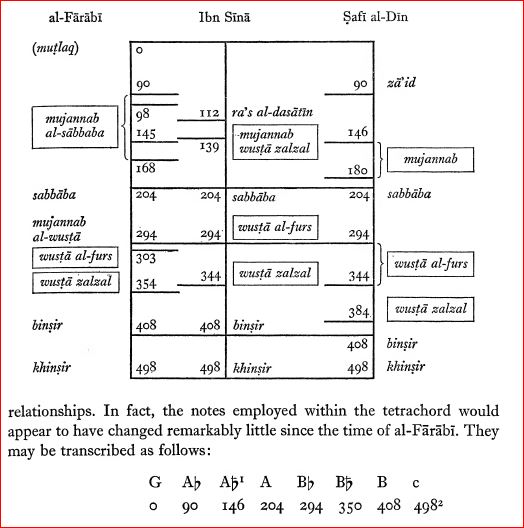
Different regions at the same time and at different times may have slightly different Bd or Ed notes by having it flat, compared to equal temperament, by 1, 2 commas or in-between. But everyone listening can apparently tell which 'mode'/'colour' the music is in, so the differences do not matter for the purposes of distinguishing the musical 'colours'. I guess this is analogous to if different peoples regionally can see slightly different hues of, say, red, orange, yellow, green, blue, indigo, violet, but all can understand which general colour is being referenced.
quote:
ORIGINAL: Ricardo
Anyways your Brief musical examples have no hope but to project as C major regardless of what the gurus want. There are a ton of better ways to make the ear hear segah as tonic IMO.
I don't understand why - the examples were basically repetitions of the Ed note and dancing around it but always coming back to it. And secondly, what are these better ways to hear Ed as a tonic?
Images are resized automatically to a maximum width of 800px
 Attachment (1) Attachment (1)
_____________________________
Konstantin
|
|
|
|
REPORT THIS POST AS INAPPROPRIATE |
Date Oct. 22 2020 2:39:51
 |
|

   
Ricardo
Posts: 14806
Joined: Dec. 14 2004
From: Washington DC

|
 RE: Looking for good book on music t... (in reply to kitarist) RE: Looking for good book on music t... (in reply to kitarist)
|
|
|
quote:
I don't understand why - the examples were basically repetitions of the Ed note and dancing around it but always coming back to it. And secondly, what are these better ways to hear Ed as a tonic?
First of all I want to say I know perfectly well the 53 note situation of turkish music is NOT an actual scale, but rather, the basis of naming notes based on the TUNING SYSTEM. And I have restated many times that modal music is distinguished from tonal music FIRST and foremost by it’s specific tuning system. I have also stated in the past that most of these are based on 5th intervals being mathematically tuned (3:2), and it is with these that we arrive at musical forms that are based on limited 7 note scales (or less) in most cases.
Assuming the timing is indeed what they want as notated, the low note C leaves an impression on the ear that the starting note is the 3rd in Example 90. I mentioned back there somewhere, you can take your “segah” note and designate an open string (take this up an octave and use open E string up top and drop the pitch 1/9 of a whole step) then play the rest of the melody on the other strings (3rd and second strings in this case, and every E note hit the open E string that you have detuned). The timing also puts the low C note on “strongish” beats, and the gravity of it pulls the ear there relative to the other melodic notes. Especially where the G note (5th of C, perfectly tuned 3:2 remember) is emphasized. Example 91 appears at first to be different until the end when the C note is again clearly stated.
If I were to express the same music above where I wanted it OBVIOUS that E(1/9 flat) is the tonic of the melody, first thing you can try is tune your LOW E down 1/9th as well and double the high E pitch...but strike it in a way that the rhythm is emphasized and let the low E keep ringing out. What I would want is all the OTHER melody notes (even though they are annoyingly sharp sounding) to be heard in relation to the low string. Might help to even pluck both E’s together EVERYTIME they occur in the melody. The next thing I would want to do is get rid of ANY C notes at all. Replace these with either D natural or D# or some fancy tuned versions of those. That would take away from the gravity of the G note emphasis as well.
But to be honest, I am thinking the above stuff is not the point of the music anyway. It’s not like Indian music where a drone is used and required. I think the idea is simply to emphasize the third interval, by name and melodic practice or activity, which is the slightly flat note relative to C, lets call it a “sweet” third. So this song form is designed to emphasize the fact this sweet third is needed vs “Rast” which is some other song form that emphasizes some other melodic situations (namely switching out the major vs minor 7th equivalent intervals), despite the fact it also contains the “sweet” third, and both “modes” are equivalent of western Ionian. And then there is the nasty chargah that doesn’t have the sweet third, it has the equal tempered ugly third nobody likes, even modern western pop singers, and any guitarist that struggled to tune his guitar to major chords by ear. Anyway that is how things are looking on paper, and sounding to my ear.
_____________________________
CD's and transcriptions available here:
www.ricardomarlow.com
|
|
|
|
REPORT THIS POST AS INAPPROPRIATE |
Date Oct. 22 2020 14:36:52
 |
|
 New Messages New Messages |
 No New Messages No New Messages |
 Hot Topic w/ New Messages Hot Topic w/ New Messages |
 Hot Topic w/o New Messages Hot Topic w/o New Messages |
 Locked w/ New Messages Locked w/ New Messages |
 Locked w/o New Messages Locked w/o New Messages |
|
 Post New Thread
Post New Thread
 Reply to Message
Reply to Message
 Post New Poll
Post New Poll
 Submit Vote
Submit Vote
 Delete My Own Post
Delete My Own Post
 Delete My Own Thread
Delete My Own Thread
 Rate Posts
Rate Posts
|
|
|
Forum Software powered by ASP Playground Advanced Edition 2.0.5
Copyright © 2000 - 2003 ASPPlayground.NET |
6.640625E-02 secs.
|


 Printable Version
Printable Version



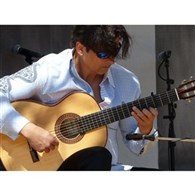








 New Messages
New Messages No New Messages
No New Messages Hot Topic w/ New Messages
Hot Topic w/ New Messages Hot Topic w/o New Messages
Hot Topic w/o New Messages Locked w/ New Messages
Locked w/ New Messages Locked w/o New Messages
Locked w/o New Messages Post New Thread
Post New Thread